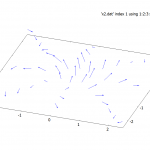Many thanks indeed to co author Horst Eckardt! As can be seen these flows can become complicated very quickly, and sometimes go over into chaotic behaviour. The free electromagnetic field will behave like this so there is no possibility that the free field is pure transverse as in standard physics. The animations will look very interesting. I will now go on to investigate these solutions for the Proca equation, which for self consistency should replace the d’Alembert equation. Then the plan is to write up UFT258 and continue with the systematic investigation of the geometrical nature of charge current density. The animations can be archived in the animation section of www.aias.us. I will also look for Beltrami solutions for charge current density. If the electron charge has a Beltrami structure it would open up a new area of physics once again.
The structure of electric and magnetic charge / current density “echoes” that of the field equation, so I should think that here will be Beltrami solutions for the charge current densities, and also for nuclear physics. Of course these solutions also apply to gravitational physics in ECE theory.
Sent: 27/02/2014 10:34:59 GMT Standard Time
Subj: Re: Animations and Particles and Birkeland FieldsI just investigated and plotted the Lundquist solution:
with
kappa =From computer algebra the divergence is zero but it is not clear if the Beltrami condition is met due to complicated identities between Bessel functions. Numerical evaluation gives the clear result that this is indeed a Beltrami function. It looks quite complicated in a 3D plot, therefore in Fig. 3 only one plane is plotted. The vetors rotate around rays in the radial direction. There is a strong central longitudinal component. Viewed from above (XY plane, Fig. 4) it can be seen that all vectors have the same angle of 45° against the radial direction. Will do a animation at the weekend, this may give surprising results.
Horst
EMyrone@aol.com hat am 27. Februar 2014 um 11:09 geschrieben:
Excellent discussion! All these solutions are also solutions for the free electromagnetic field, so that is the very end (once again) of the Higgs boson, assuming that an expensive figment of opiate nightmare has a beginning and end. The reason is that all these free field solutions have longitudinal components and are not U(1) gauge invariant. If the Higgs boson existed there would be no longitudinal solutions. These Beltrami solutions are observable in plasma flows, cosmology and hydrodynamics, they cause a river to meander. The simplest longitudinal solution is B(3), which is observed in the inverse Faraday effect as a static, longitudinal, magnetization. This was first observed fifty years ago at Havard in the group of the Nobel Laureate Bloembergen, who was co discoverer of the laser. The spectacular jet of a whirlpool galaxy is due to a B(3) type field, or a more complicated Beltrami longitudinal field.
Subj: Re: Animations and Particles
This email probably did not come through, new attempt.
Horst Eckardt hat am 26. Februar 2014 um 19:36 geschrieben:
Norman,
Obviously eqs. (18) and (21) are exactly the Bessel function example I have plotted and animated. Figs. 6 and 9 are density plots for the plane Z=0. I will provide such a plot. There are zero crossings as is explained in the text of the article. In Fig. 6 the zones have been levelled out in certain radius regions, in my plot they will look more continuous.
Horst
is there a formula describing a Birkeland current? Then we could check if it is obeys a Beltrami condition.
> Norman Page hat am 26. Februar 2014 um 17:13 geschrieben:
>
>
> Horst Another great animation. Check Fig 6 at
> http://electric-cosmos.org/BirkelandFields.pdf
> To see matter concentrations in Birkeland currents.
> Could be a X section through the electron shells of an atom. Like your
> animation.? Best Regards Norman Page
- fig32
- fig41

